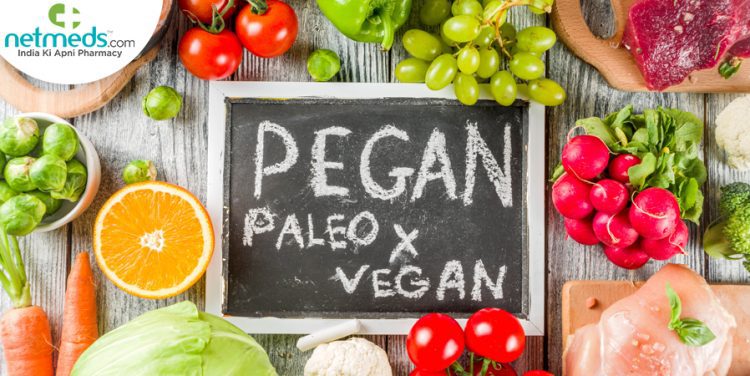The Pegan diet is a way of eating that combines the principles of the most famous diet trends -paleo and vegan. Formulated by Dr Mark Hyman, Pegan eating pattern claims to augment health by lowering inflammation and regulating blood sugar levels. The Pegan diet mainly focuses on a plant-based lifestyle accompanied by adding a limited portion of grass-fed meat and healthy fats. This diet pattern is believed to help fight disease while also being favourable for the environment.
Read this article to get an insight into its potential health benefits, foods to add and avoid and drawbacks of this diet trend.
What Is The Pegan Diet?
The Pegan diet relates the key principles of paleo and vegan diets based on the concept that nutrient-dense, wholesome foods that can lessen inflammation, maintain blood sugar, and support overall health and being.
Optimise Your Overall Health And Well-Being, Buy From Our Wide Range Of Nutritional Supplements, Right Here!
The Pegan diet is exceptional and has its own set of guidelines, while it’s less limiting than a paleo or vegan diet. It mainly focuses on eating vegetables and fruit but let’s one to add small to medium portions of meat, fish, nut, seeds, and some legumes are also permitted. While highly processed sugars, oils and refined grains are limited, but still allowed in very minimal quantity.
Moreover, this eating pattern is not formulated as short-term eating behaviour. Instead, it mainly aims to be more sustainable so that one can follow it in long term.
Also Read: Health Benefits Of Going Paleo
Foods To Include
The Pegan diet chiefly encourages adding a lot of whole foods that have undergone minimal processing.
Add Plenty Of Plant-Based Foods
The main food group allowed liberally in the Pegan diet is vegetables and fruits, which comprise around 75% of a person’s total intake.
It mainly encourages adding low glycaemic index fruits and veggies like berries and non-starchy vegetables, so as to regulate blood sugar spikes.
While it also allows very minimal amounts of starchy veggies and sugary fruits for ones who have already attained good blood sugar control prior to beginning the diet.
Choose Healthy protein
Though the Pegan diet mainly focuses on plant foods, adequate protein intake from animal sources is still allowed. Less than 25% should come from animal-based protein. Essentially you are allowed to have a lower meat intake than you would on a typical paleo diet, but still more than on a vegan diet.
However, this diet restricts eating conventionally farmed meats or eggs. Instead, it stresses adding grass-fed sources of meat, poultry, and whole eggs. Also allows adding low mercury content fish like sardines and wild salmon.
Also Read: Top 3 Vegan Probiotic Foods To Boost Your Overall Health
Healthy Fat Sources Such As:
- All nuts, except peanuts
- Seeds
- Avocado and olives
- Coconut and virgin coconut oil
- Omega-3s low mercury content fish
Grains
Though most cereals and legumes are restricted on the pegan diet due to their potential to influence blood glucose response, a few gluten-free whole grains and legumes are allowed in limited amounts.
Whole grain intake should not exceed more than 125 grams (½ cup) per meal, while legumes intake should not go beyond 75 grams (1 cup) per day.
Some of the grains and legumes that you may include:
Grains: Millets, oats, quinoa, black rice,
Legumes: Lentils, chickpeas, black beans
Also, the diet further restricts grains and legumes if a person has diabetes or other comorbid condition that contributes to bad blood glucose control.
Foods To Avoid
The Pegan diet is more flexible than the paleo or vegan diet as it lets occasional intake of most food groups.
Foods To Be Avoided:
- Cow’s milk, yoghurt, and cheese. Sometimes grass-fed butter is allowed
- Gluten-containing grains
- Most legumes
- Sugar and sugar-laden foods
- Refined oils – canola, soybean, sunflower, and corn oil
- Food additives, artificial colour, preservatives, and flavourings
Potential Benefits
The Pegan diet is believed to contribute to good health status and well-being in several ways.
The diet allows adding a lot of fruits and vegetables which are essentially a treasure trove of dense nutrients. They are endowed with natural dietary fibre, vitamins, minerals, and bioactive plant compounds that are known to avert disease and lessen oxidative stress and inflammation.
The Pegan diet also stresses eating healthy, unsaturated fats from fish, nuts, seeds, and other plants that may have a positive effect on heart health.
Additionally, this diet relies on whole foods and contains very less highly processed foods that are linked to an enhancement in overall diet quality and health status.
Downsides:
Though the Pegan diet is more flexible than a vegan or paleo diet, most of the claimed restrictions unnecessarily limit healthy foods like legumes, whole grains, and dairy.
Unless a person has specific allergies or intolerances, it’s not necessary to avoid them. Moreover, random elimination of large food groups can lead to nutrient deficiency, if those nutrients are not substituted. Also, a person may need a basic understanding of food and nutrition to start the Pegan diet safely.
The lack of accessibility to organic fruits, vegetables and grass-fed meats for most people is also one of the downsides.
Source by www.netmeds.com


